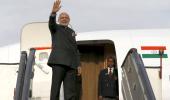While Narendra Modi has spent fewer days abroad than his predecessor -- 275 days versus Dr Manmohan Singh's 306 -- he has travelled more widely than any other Indian PM.

Prime Minister Narendra Modi's three-day visit to the United Arab Emirates and Qatar, from which he returned home last week, was probably his last foreign visit in his current term.
According to data available on the Web sites of the ministry of external affairs and the prime minister's office, Modi has undertaken 76 foreign visits as prime minister since his maiden visit to Bhutan on June 15-16, 2014.
His predecessor, Dr Manmohan Singh, completed 73 foreign visits in his 10 years at the helm, from his first to Thailand to attend the BIMSTEC Summit on July 29, 2004 to his last on March 3, 2014 to Myanmar, which ironically was also to take part in the BIMSTEC Summit -- highlighting the increasing importance of multilateral engagements, especially in the Indian Ocean region, during his tenure.
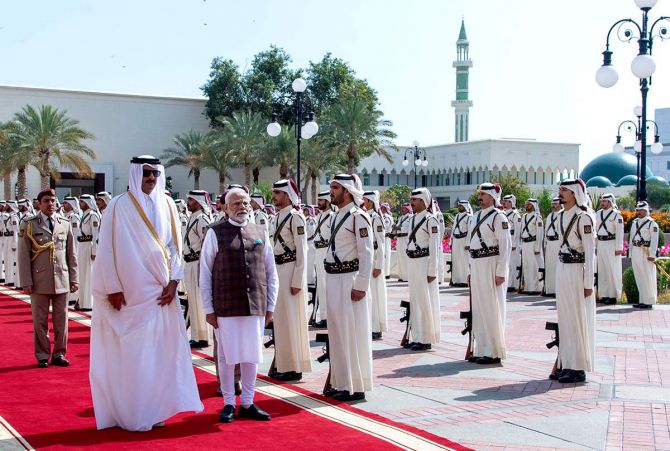
Data suggests that while Modi has spent fewer days abroad than his predecessor -- 275 days versus Singh's 306 -- he has travelled more widely and strenuously than any other Indian PM.
Modi has increased India's engagement at the highest diplomatic level with the country's immediate neighbourhood in South Asia and its extended ones in Southeast, Central, and West Asia.
Singh undertook 35 visits abroad in his first term and 38 in his second.
Modi went on 49 overseas visits in his first term and 27 in his second term.
Two years of the COVID-19 pandemic meant that Modi didn't undertake a single foreign visit in 2020 and only three in 2021, while attending at least 16 bilateral and multilateral virtual summits in 2020 and at least nine in 2021.
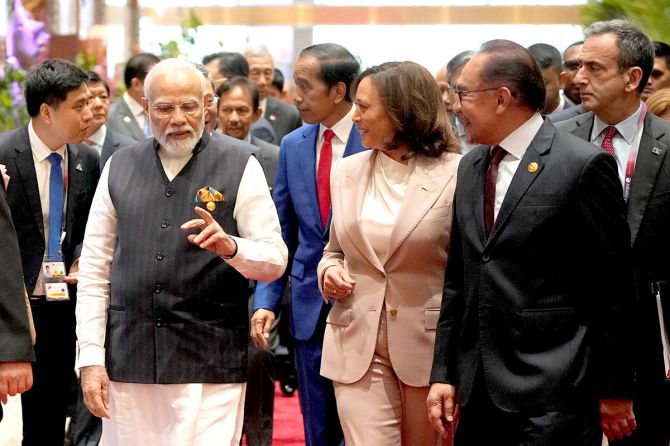
A highlight of Modi's 10 years of diplomacy was his outreach to the Indian diaspora.
He also travelled more often to India's South Asian neighbours as New Delhi tried countering the growing Chinese influence, particularly in Bangladesh.
Modi visited Nepal five times, while Dr Singh did not go to Kathmandu even once.
Another highlight was Modi's foreign policy towards the Arab world and West Asia.
During his recent UAE visit, the PM noted that it was his seventh since 2015, when he became the first Indian PM to visit that country in 34 years.
The UAE, he reminded the Indians gathered at Abu Dhabi's Sheikh Zayed Sports Stadium, had awarded him its highest civilian honour.
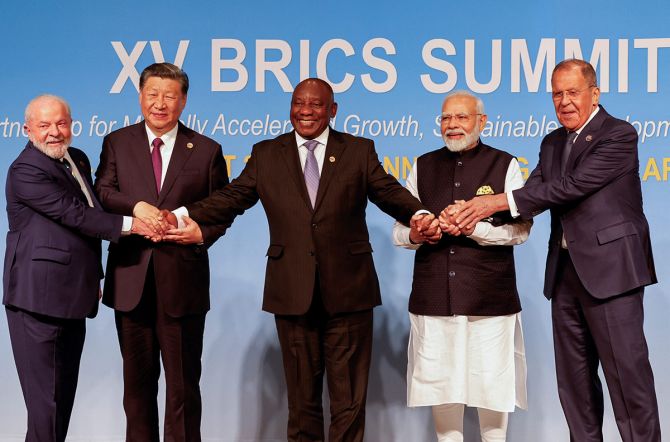
The PM de-hyphenated India's relations with Israel and Palestine, visiting Tel Aviv in July 2017, the first ever by an Indian PM, and Palestine a year later.
A feature of the Manmohan Singh years was his deepening of P V Narasimha Rao's 'Look East Policy', with as many as 14 visits to the ASEAN region, visiting each of the 10 member States at least once.
Modi kept the engagement alive, but his visits to the Asean region were less frequent.
Modi's 2nd term: 27 overseas visits focused on foreign policy outreach
Mobility pacts that opened the door for Indian skilled labour were among key successes
Modi recently concluded a visit to the United Arab Emirates, marking his seventh trip to the nation. However, it was his unexpected stopover in Qatar that stole the headlines, coming just days after the country released eight Indian Navy veterans, who were earlier facing the death penalty.
Despite the reduced number of trips by Modi in his second term as PM, each had been carefully selected to maximise foreign policy outreach and access to international leaders, according to Rajiv Bhatia, a former ambassador and distinguished fellow at the foreign policy think-tank Gateway House.
Ambassador Bhatia cited Modi's attendance at the 15th BRICS Summit in South Africa and the East Asia Summit in Jakarta, Indonesia, as key examples of the PM's strategic diplomacy.
These events were held just days before India hosted the G20 Leaders Summit in New Delhi, the ambassador noted.
Modi's image as a foreign policy-focused PM has been further consolidated during this term, Ambassador Bhatia pointed out.
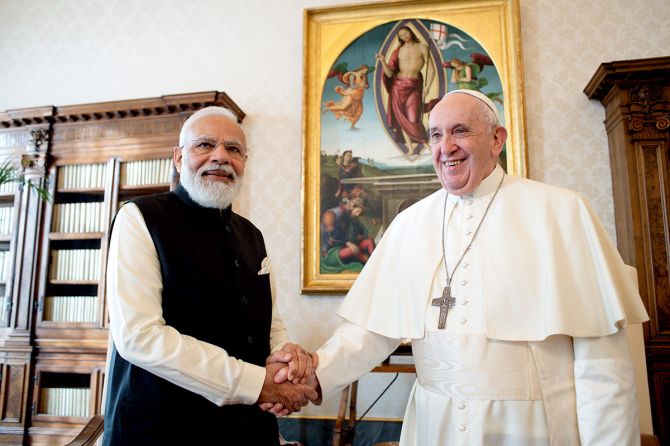
After visiting a wide range of countries in his first term, Modi shifted his focus to major global powers and trade partners such as the United States, Germany, and France, which received multiple visits.
His trips to Kyrgyzstan and Uzbekistan for the Shanghai Cooperation Organisation summits in 2019 and 2022, respectively, underscored India's efforts to establish ties with the mineral-rich Central Asian region.
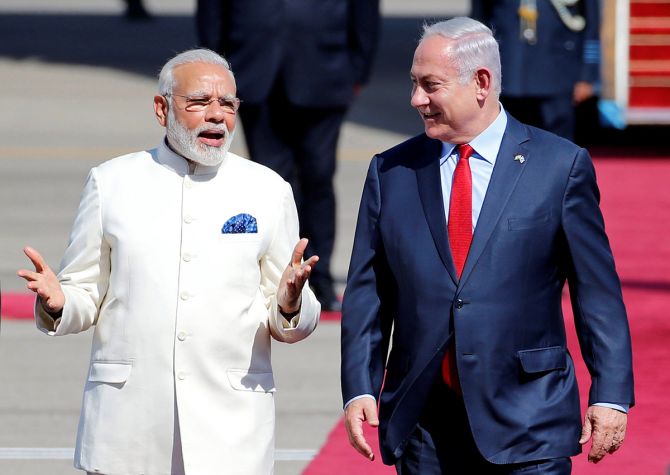
Key places revisited after a long break
Modi's second term as PM also saw an Indian leader visiting certain key nations after a long hiatus.
His trip to the Vatican City in October 2021 marked the first meeting between an Indian PM and the Pope in two decades.
In August 2023, Modi embarked on a two-day visit to Greece, the first by an Indian PM in 40 years.
This visit was particularly significant given the global surge in shipping charges due to logistics disruptions caused by the war in Ukraine and volatility in commodity prices.
Greek firms are major players in global merchant shipping, with the country's ship-owners owning a fifth of the world's fleet.
The country's media also reported that India discussed exploring alternative export routes after Brexit, with a focus on Piraeus, Greece's largest port.
The country is also being eyed by India as a key staging point for Indian exports to Europe, as part of the proposed India-Middle East-Europe Economic Corridor.
Though the PM visited fewer African nations during his second stint in office, visits to South Africa and Egypt saw him stress on India's credentials of being a long-standing friend of the continent.
Trips made to countries like Papua New Guinea in May 2023, also opened up new ties with parts of the world where Indian presence has been minimal.
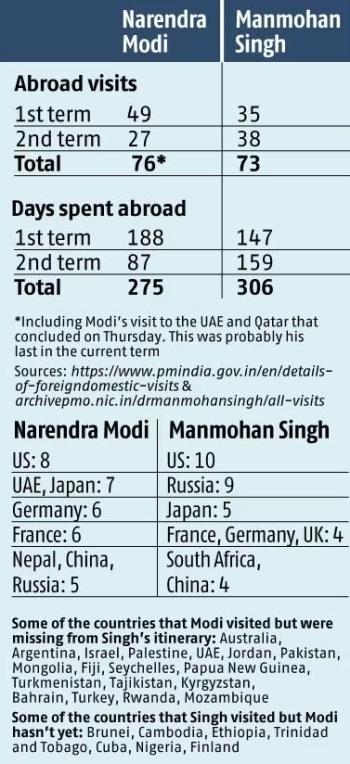
Indian skilled labour
Modi's visit to Greece furthered a key foreign policy objective, with both nations agreeing to a critical migration and mobility pact.
Months later, Greece, facing a severe shortage of at least 70,000 agricultural workers for the domestic production of vegetables, fruit, olive oil, and milk, turned to India for workers.
Developed nations, grappling with escalating labour costs and inflation, are experiencing a significant worker shortage. India has stepped in to fill this gap.
Last year, the Cabinet greenlit a mobility pact with Italy, a discussion that originated during the prime minister's visit to Rome in October 2021.
A similar agreement was inked with Australia in May 2023 during the PM's visit.
The conclusion of these mobility pacts -- hailed as unique opportunities for India's skilled youth -- has been a priority during many of the prime minister's bilateral visits.
The agreements signed with France, the United Kingdom, Germany, and Finland during the prime minister's second term are a testament to this.
Discussions have now commenced with countries, such as South Korea, a destination for both skilled and low-skilled Indian workers.
Last fortnight, India signed a mobility pact with Taiwan, a country with limited access to the global labour market due to Chinese opposition.
As the Israel-Hamas conflict continues, Tel Aviv is seeking to rapidly import foreign workers to fill nearly 90,000 jobs previously held by Palestinians.
Screening camps have been established in Delhi, Chennai, and other cities by the Israel Builders Association.
Photographs curated by Manisha Kotian/Rediff.com
Feature Presentation: Rajesh Alva/Rediff.com


